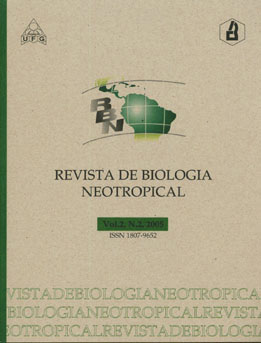Competição, facilitação ou teoria neutra? Um estufo das interações e de sua importância na estrutura de uma comunidade vegetal em regeneração
DOI:
https://doi.org/10.5216/rbn.v4i2.5211Keywords:
Competição, comunidades vegetais, facilitação, Teoria NeutraAbstract
Nowadays, most ecologists have been working based only on “negative” interactions, such as predation and competition. However, recent studies suggest that facilitative interactions can be as important as the negative ones, and their inclusion in ecological models may produce surprising results. This study aimed at clarifying if some plant species can develop facilitative or competitive actions in relation to others and was carried out in an area recently used in a reforestation project to recover its gallery forest. Forty points planted in the reforestation project were randomly chosen to evaluate the plant species present in the surrounding area and measure their dry weight. The results did not show any differences between the points where the reforestation was successful or unsuccessful or the presence of an indicator species. Although it was not possible to identify the most important type of interaction occurring in this community, it should be pointed out that its structure might have been influenced by stochastic factors, as suggested by the Neutral Theory. These results could also imply that this community is still on an early stage of succession, presenting a high proportion of r-selected species.Downloads
References
Alonso, D., R. S. Etienne & A. J. McKane. 2006. The merits of neutral theory. Trends Ecol. Evol. 21: 451-457.
Begon, M., C. R. Townsend & J. L. Harper. 2006. Ecology: from individuals to ecosystems. 4th ed., Blackwell Publishing, Malden, 738 pp.
Bertness, M. D. & R. M. Callaway. 1994. Positive interactions in communities. Trends Ecol. Evol. 9: 187-191.
Bruno, J. F., J. J. Stachowicz & M. D. Bertness. 2003. Inclusion of facilitation into ecological theory. Trends Ecol. Evol. 18: 119-125.
Callaway, R. M. 1995. Positive interactions among plants. Bot. Rev. 61: 306-349. Callaway, R. M. & L. R. Walker. 1997. Competition and facilitation: a synthetic approach to interactions in plant communities. Ecol. 78: 1958-1965.
Choler, P., R. Michalet & R. M. Callaway. 2001. Facilitation and competition on gradients in alpine plant communities. Ecol. 82: 3295-3308.
Dufrêne, M. & P. Legendre. 1997. Species assemblages and indicator species: the need for a flexible asymmetrical approach. Ecol. Monogr. 67: 345-366.
Goldberg, D. E., T. Rajaniemi, J. Gurevitch & A. Stewart-Oaten. 1999. Empirical approachs to quantifying interaction intensity: competition and facilitation along productivity gradients. Ecol. 80: 1118-1131.
Hubbell, S. P. 2001. The unified neutral theory of biodiversity and biogeography. 1st ed., Princeton University Press, Princeton, 375 pp.
Hutchinson, G. E. 1957. Concluding remarks. Cold Spring Harbor Symp. Quant. Biol. 22: 415-427.
Lorenzi, H. 2000. Plantas daninhas do Brasil: terrestres, aquáticas, parasitas e tóxicas. 3. ed., Instituto Plantarum de Estudos da Flora, Nova Odessa, 640 pp.
Pianka, E. R. 1970. On r- and K-selection. Am. Nat. 104: 592-597.
Putman, R. J. 1994. Community ecology. 1st. ed., Chapman & Hall, London, 173 pp.
Shouse, B. 2003. Conflict over cooperation. Sci. 299: 644-646.
Silveira, R. L., D. Brandão & D. A. Costa.
Estrutura da comunidade de plantas invasoras da área de floresta ciliar do rio Meia Ponte, em Goiânia. Anais do VI Congresso de Ecologia do Brasil, 2: 139- 140.
Wiegand, T., C. V. S. Gunatilleke, I. A. U. N. Gunatilleke & A. Huth. 2007. How individual species structure diversity in tropical forests. PNAS, 104: 19029-19033.
Downloads
Published
How to Cite
Issue
Section
License
The expontaneos submmition of the manuscript automaticaly implies in the cession of all patrimonial rights for the Journal of Neotropical Bilogy (RBN) after publication. The autor allow the right of first publication of the article to the RBN, under Creative Commons Attribution 4.0 (CC BY-NC 4.0) Licence.
There are garanties for the authors to the authorial and moral rights, for each one of the articles published by RBN, with permissions:
1. The use of article and contents for the education and researches.
2. The use of the article and their contents, linking to the Article on the web site of the RBN, allowing the divulgation on:
- institutional closed web (intranet).
- open access repositories.
3. Preparation and divulgation of the other publication derived from the article and its content, if there is citation of the original publication by RBN.
4. Make printed copies in small quatinties for personal use.

















